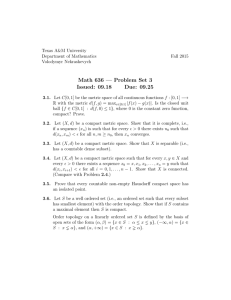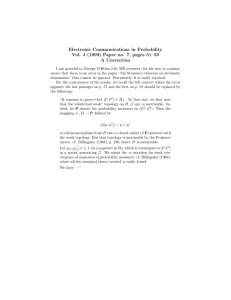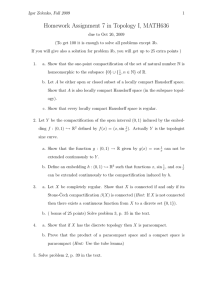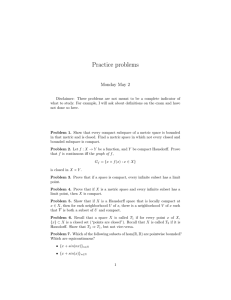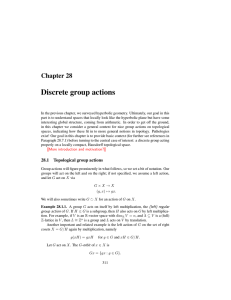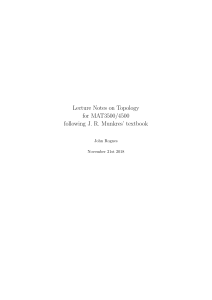Homework 4, Math 5510 September 22, 2015 Section 28: 1, 6
advertisement
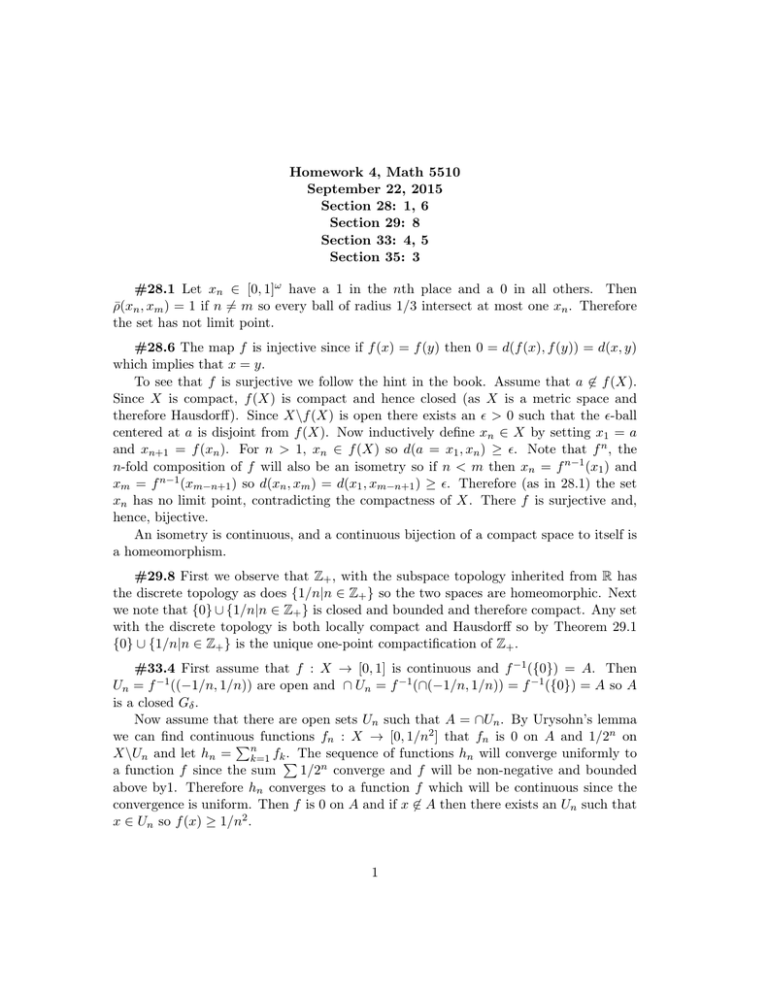
Homework 4, Math 5510
September 22, 2015
Section 28: 1, 6
Section 29: 8
Section 33: 4, 5
Section 35: 3
#28.1 Let xn ∈ [0, 1]ω have a 1 in the nth place and a 0 in all others. Then
ρ̄(xn , xm ) = 1 if n 6= m so every ball of radius 1/3 intersect at most one xn . Therefore
the set has not limit point.
#28.6 The map f is injective since if f (x) = f (y) then 0 = d(f (x), f (y)) = d(x, y)
which implies that x = y.
To see that f is surjective we follow the hint in the book. Assume that a 6∈ f (X).
Since X is compact, f (X) is compact and hence closed (as X is a metric space and
therefore Hausdorff). Since X\f (X) is open there exists an > 0 such that the -ball
centered at a is disjoint from f (X). Now inductively define xn ∈ X by setting x1 = a
and xn+1 = f (xn ). For n > 1, xn ∈ f (X) so d(a = x1 , xn ) ≥ . Note that f n , the
n-fold composition of f will also be an isometry so if n < m then xn = f n−1 (x1 ) and
xm = f n−1 (xm−n+1 ) so d(xn , xm ) = d(x1 , xm−n+1 ) ≥ . Therefore (as in 28.1) the set
xn has no limit point, contradicting the compactness of X. There f is surjective and,
hence, bijective.
An isometry is continuous, and a continuous bijection of a compact space to itself is
a homeomorphism.
#29.8 First we observe that Z+ , with the subspace topology inherited from R has
the discrete topology as does {1/n|n ∈ Z+ } so the two spaces are homeomorphic. Next
we note that {0} ∪ {1/n|n ∈ Z+ } is closed and bounded and therefore compact. Any set
with the discrete topology is both locally compact and Hausdorff so by Theorem 29.1
{0} ∪ {1/n|n ∈ Z+ } is the unique one-point compactification of Z+ .
#33.4 First assume that f : X → [0, 1] is continuous and f −1 ({0}) = A. Then
Un = f −1 ((−1/n, 1/n)) are open and ∩ Un = f −1 (∩(−1/n, 1/n)) = f −1 ({0}) = A so A
is a closed Gδ .
Now assume that there are open sets Un such that A = ∩Un . By Urysohn’s lemma
2
n
we can find continuous
Pn functions fn : X → [0, 1/n ] that fn is 0 on A and 1/2 on
X\Un and let hn = k=1 fkP
. The sequence of functions hn will converge uniformly to
a function f since the sum
1/2n converge and f will be non-negative and bounded
above by1. Therefore hn converges to a function f which will be continuous since the
convergence is uniform. Then f is 0 on A and if x 6∈ A then there exists an Un such that
x ∈ Un so f (x) ≥ 1/n2 .
1
#33.5 First we show the the existence of the function f . By 33.4 we have functions
A
fA , fB : X → [0, 1] that vanish exactly on A and B, respectively. Then f = fAf+f
is the
B
desired function.
If f : X → [0, 1] is continuous and is 0 on exactly on A and 1 exactly on B then A
is a closed Gδ by applying 33.4 to f and B is a closed Gδ by applying 33.4 to 1 − f .
#35.3 We first show that (1) ⇒ (2). Assume there is a continuous map f : X → R
that is not bounded. Then f is a homeomorphism to its graph in X × R. There is a
product metric on X ×R and the subspace metric on the graph of f will be an unbounded
metric on X.
Next we show that (2) ⇒ (3). If X is not limit point compact then there exists a
countable set A that doesn’t have a limit point. Since X is metrizable it is Hausdorff. For
each x ∈ A has a neighborhood U such that U ∩ A has finitely many points x, x1 , . . . , xn .
Let Ui be a neighborhood of x that is disjoint form xi . Then the intersection of U with
∩ Ui will be an open neighborhood of x that only contains x in its intersection with A.
In particular the subspace topology on A is the discrete topology. We can then find on
surjective, continuous function from A to Z+ (since all functions from a space with the
discrete topology are continuous) which extends to a continuous function on all of X by
the Tietze extension theorem.
Finally, we show that (3) ⇒ (1). Assume that X has an unbounded metric d. Then
there exists a sequence of points xn with d(x1 , xn ) → ∞. But then xn does not have a
convergent subsequence, contradiction.
2
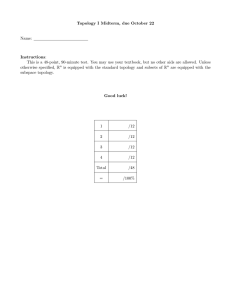
![MA342A (Harmonic Analysis 1) Tutorial sheet 2 [October 22, 2015] Name: Solutions](http://s2.studylib.net/store/data/010415895_1-3c73ea7fb0d03577c3fa0d7592390be4-300x300.png)
